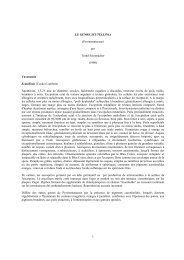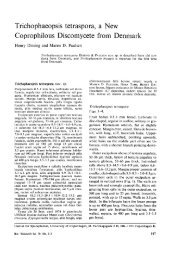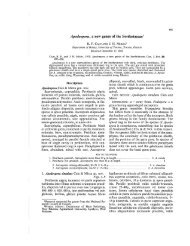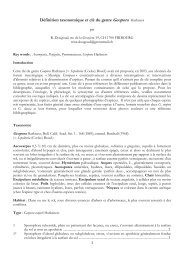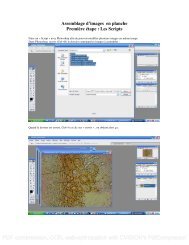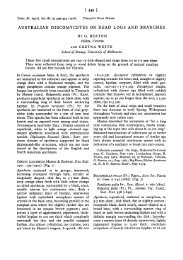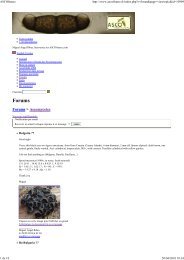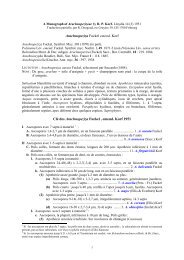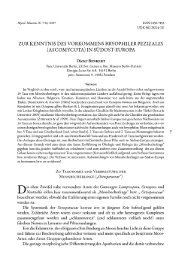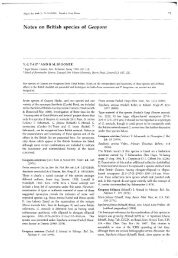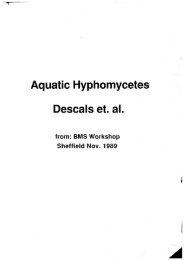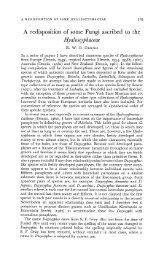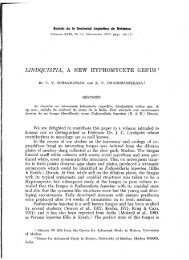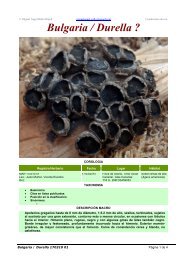Stray Studies in the Coronophorales (Pyrenomycetes) 4-8 - ASCOfrance
Stray Studies in the Coronophorales (Pyrenomycetes) 4-8 - ASCOfrance
Stray Studies in the Coronophorales (Pyrenomycetes) 4-8 - ASCOfrance
Create successful ePaper yourself
Turn your PDF publications into a flip-book with our unique Google optimized e-Paper software.
316 J. A. Nannfeldtspicuous <strong>in</strong> spite of <strong>the</strong> m<strong>in</strong>uteness of its ascocarps, appears evidently more frequently<strong>in</strong> certa<strong>in</strong> years (spr<strong>in</strong>gs) and may <strong>the</strong>n be fairly copious <strong>in</strong> its localities.(18) Nitschkia pezizoidea (Pat. & Gaill.) O. Kze, Rev. gen. pi. 3(2): 501 (1898;"Nitschkeapezizodea").Coelosphaeria pezizoidea Pat. & Gaill., Bull. Soc. Mycol. Fr. 4(3): 106 (1889;"Caelosphaeria"). — W<strong>in</strong>ter<strong>in</strong>a (?) pezizoidea Höhn., Ann. Mycol 16(1-2): 105 (1918). —Typus: Venezuela, Gaillard 266 (PC).Similar to N. grevillii. Ascocarps 0.35-0.45 mm, collaps<strong>in</strong>g <strong>in</strong>to deeply cupulate,apical papilla unusually prom<strong>in</strong>ent. Asci 8-sporous. Spores fusiform to ovoid,straight, 7-11x2-3 fxm, hyal<strong>in</strong>e, eventually with a dist<strong>in</strong>ct septum. (Compiled fromFitzpatrick 1923:52.)DISTRIBUTION: South America (Venezuela). Only <strong>the</strong> type collection.(19) Nitschkia similis (Bres.) Nannf. nov. comb.Trichosphaerella similis Bres., Bull. Jard. Bot. Bruxelles 4(1);7 (1914). — Scortech<strong>in</strong>iellasimilis Arx & Müll., Beitr. Krypt.-fl. Schweiz 11(1): 383 (1953). — Typus: Zaïre, Vanderyst(S!).Similar to N. acanthostromabut <strong>the</strong> dichotomously branched end<strong>in</strong>gs of <strong>the</strong>subicular hyphae not sp<strong>in</strong>y. Ascocarps 0.3-0.5 mm. Asci ca. 32-sporous. Sporesreniform to suballantoid, often also spirally twisted (up to 90°), hyal<strong>in</strong>e, with afiliform, ca. 5 /xm long curved appendix at each end, 6-9x3 /xm, and with 2 largedrops, almost fill<strong>in</strong>g <strong>the</strong> lumen, and eventually with a dist<strong>in</strong>ct (pseudo?)septum.DISTRIBUTION: Tropical Africa (Zaïre). Only <strong>the</strong> type collection.(20) Nitschkia tetraspora Nannf. nov. spec.N. collapsa similis et certe aff<strong>in</strong>is. Differt praecipue sporis angustioribus et longioribus(15-22x2.5-3 /urn), <strong>in</strong>itio octonis <strong>in</strong> asco sed normaliter quaternis tantum maturescentibus.Ascocarpia (sicca) cupulato-collapsa (0.4-0.5x0.25-0.3 mm), papilla apicali parva <strong>in</strong>conspicua.Sporae anguste fusiformes, rectae vel <strong>in</strong>terdum leviter curvatae, 1-septatae, pariete deniquefuscescente.Typus: Kenya, Nannfeldt 22058 (holotypus: UPS; isotypus: S).Subiculum absent or scanty. Ascocarps scattered to densely gregarious, seated on peridermor on <strong>in</strong>ner-bark beneath loosen<strong>in</strong>g parts of <strong>the</strong> periderm, turb<strong>in</strong>ate and (when dry) collapsed tocupshape, 0.4-0.5x0.25-0.3 mm, <strong>the</strong> apical papilla very small. Asci 25-30x8-11 /x (p. sp.),early deliquesent, <strong>in</strong>itially 8-spored, but as a rule only (<strong>the</strong> upper) 4 spores reach maturity.Spores fusiform, straight or sometimes slightly curved, 15-22x2.5-3 ¡xm, with <strong>in</strong>itially 4-6drops, later confluent to 2 and at a certa<strong>in</strong> stage almost fill<strong>in</strong>g <strong>the</strong> lumen, successively gett<strong>in</strong>g amedian septum and constriction; wall smooth, eventually smoky-grey. Abortive spores acicularto narrowly fusiform (ca. 16x 1-1.5 /xm), hyal<strong>in</strong>e, 1-septate.DISTRIBUTION: Tropical Africa (Ghana, Kenya, Sierra Leone).SvenskBot. Tidskr. 69 (1975)



